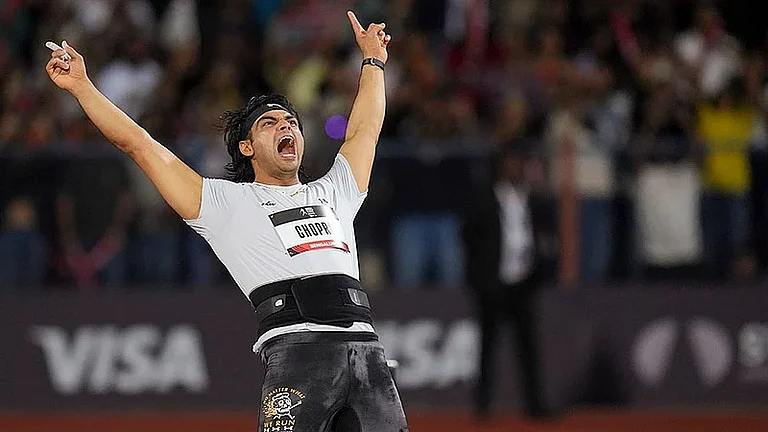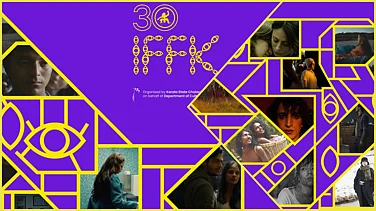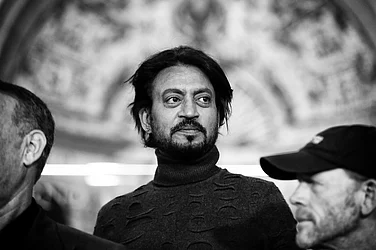Before shooting Silsila (1981), Yash Chopra ran into a problem. No, not the controversial cast—comprising Amitabh Bachchan, Jaya Bachchan, and Rekha—this trouble had a poetic lilt. The second part of the song—“Dekha ek khwaab toh ek silsile hue/Door tak nighaaon mein hai gul khile hue” (As far as I can see, I can only see flowers)—tripped him. Where in this world would he find such a place? He asked Amitabh. The actor showed him a clip on his mini-projector: a garden awash in tulips. As far as Chopra could see, he could, indeed, just see flowers. He flew to the Keukenhof Gardens in Amsterdam, setting a trend synonymous with Hindi cinema: romantic songs shot in foreign locations.
Even though Chopra first travelled to the Netherlands, a country down south became his adoptive home: Switzerland. That’s where he shot his next, Faasle (1985), then Chandni (1989), then Darr (1993). (He set his 1991 drama, Lamhe, in London.) In the first two decades of his career, in fact, Chopra hadn’t left India. “Initially I used to shoot my films in Kashmir or Shimla,” he recalled in an interview, “but with the terrorism threat in Kashmir and the lack of adequate infrastructure in Shimla, I had to find an alternative.” His wife, Pam, elaborated: “You hardly needed permissions in Switzerland. But in India, if you had to shoot in a train, you had to start the paperwork six months in advance.”
So for an aesthetic-driven motive, a foreign locale meant geographical beauty—something literally unseen—a place to parachute in and out from. That’s why Silsila, otherwise set in Delhi, used Amsterdam as a backdrop, much like the LED walls in virtual production. And even though Chandni and Darr weaved locations as part of their narratives—it’s where the lead couples celebrate their honeymoons—the foreign countries, and their people, didn’t affect the stories in any memorable way. That’d change two years later, with the release of another Yash Raj production, Dilwale Dulhania Le Jayenge (1995, DDLJ), where the setting would itself become a character.
A drama that used the foreign to spotlight the native: seeing others became a way to see one’s self—what they are, what we are not; what we protect, what they flaunt. Take its first scene, where an immigrant, Baldev Singh (Amrish Puri), in London’s Trafalgar Square, draws a remarkable parallel between himself and the pigeons he’s feeding: “They are just like me—they also don’t have a country.” When his daughter, Simran (Kajol), wakes up hungover in a hotel room in Switzerland, fearing she’s lost her virginity, the hero, Raj (Shah Rukh Khan), assuages her anxiety, saying he understands and respects the “izzat” of a “Hindustani ladki”. Earlier in the film, he waves off the pestering cops on a highway, saying, “Bye-o, bye-o! Al Pacino! I’m a kutto, I’m a kamino, I’m a saalo!”—an inside joke shared between the actor and the Indian audiences, for it is delivered in Hindi, excluding the foreigners, contriving an excuse to assert ‘Indian superiority’, a pattern that’d devolve into ridicule, popping most crassly in Salaam Namaste (2005) and Jab Harry Met Sejal (2017).
DDLJ’s director, Aditya Chopra, had unwittingly turned the clock backwards, as Bollywood films in the 1960s had also travelled around the world to absorb the essence of home. This story even had poetic circularity because his idol, Raj Kapoor, had pioneered the trend by setting Sangam (1964) in London, Paris and Geneva. The 60s, a decade doused in political subtext: a young country itching to assert itself on the global stage; a country whose political masters used cinema for “nation building”; a country wrecked by unemployment, illiteracy, and foreign threats.
So it made perfect sense that Sangam’s overseas portion opened to the shot of an Indian tricolour above an apartment complex, which cut to Radha (Vyjayanthimala) and Sundar (Kapoor), an Indian Air Force officer wearing a uniform, under it. Even the identities of the camera and the characters merge: both tourists, both voyeurs. Many scenes unfold via wide and long shots, capturing the considerable expanse of the foreign land. The camera adopts a tourist’s gaze, panning from the top to the bottom while exploring monuments. Such language informs several Hindi dramas after Sangam, devoting increased screen time to foreign locales, such as Love in Tokyo (1966) and An Evening in Paris (1967). “The protagonist in these films is like a ‘tourist’,” writes Madhuja Mukherjee in Travels of Bollywood Cinema (2014), “gathering mementos and photos without interacting with the locals.”
Sometimes the excitement spills, as Sundar describes to his best friend: “By the time you read this [letter], we’ll be on top of the Eiffel Tower, Gopal!” In another sequence, a luxury store allures Radha, who keeps admiring a gorgeous handbag—as if she’s a version of future India, both in real-life and cinema, a bottomless receptacle of capitalist consumerism. Sundar, on the other hand, caresses a glass window, fixating on a bagpipe. Cash-strapped, they break into an argument about what to buy. “There are only two beautiful things in this world,” he tells her, “one, a woman, the other, a bagpipe. Since eternity, men have suffered hardships, given sacrifices. I’m a man as well”—he slaps a wad of notes on the table—“take this, go, buy your purse.” (It’s not tough to guess which item is ultimately bought.) Such blatant emasculation—a sense of persecution—parallels these characters’ insecure national identities, evident in many films in the decade.
In Love in Tokyo (1966), Ashok (Joy Mukherjee) keeps requesting his nephew, born to an Indian father and a Japanese mother, to return to India, only to get rebuffed. The plea continues for many scenes, denting Ashok’s pride, setting up a constant competition between India and Japan, culminating in him saying, “We’ve Taj Mahal!” The movie fetishises the country’s bodies—whether it’s buildings or women—marked by a distinct ‘oriental’ gaze.
Indian directors also used the foreign to assert their culture and differences. In Sangam, while admiring the panoramic Paris from the Eiffel Tower, Sundar and Radha see a foreign couple kiss. He, too, leans towards Radha, but she turns and covers her head with a saree. It makes two old women clap and ask, “India? India?” In An Evening in Paris (1967), Roopa (Sharmila Tagore) refuses to kiss Sam (Shammi Kapoor), saying, “I’m an Indian girl and according to Indian custom, that … that’s only after marriage.” Such scenes, writes Madhava Prasad in Ideology of the Hindi Film, “highlight the uniqueness of the national culture and the responsibility of the characters to uphold it.”
Its most extreme example appeared in Purab Aur Paschim (1970), set in London. The hero, Bharat (Manoj Kumar), constantly asserts his identity and pride—often in front of a woman, Preeti (Saira Banu), who smokes, drinks and wears skimpy clothes. But the drama does something else, too: ridiculing and relishing the West. In many scenes, the camera focuses on foreign women’s bare legs for uncomfortably long durations, filming them from their heels upwards. The movie wears its sincerity and insecurity so hard and so often that it borders on the comical and the absurd, heightened in a song that recounts the country’s past achievements to counter the West scaling the moon.
It also hammers a remarkable assertion: the immorality of Non-Resident Indians (NRIs). Several characters in London—played by Banu, Pran and Prem Chopra—insult, or remain ignorant of, India. Preeti has never heard of Uddham Singh, Jallianwala Bagh or Amritsar (“which is in Bharat,” puppy-eyed Kumar informs her. “Now don’t ask where Bharat is.”). Prem’s OP is so sleazy, and Western morals so lax, that on a dance floor he moves from kissing one woman to the other, as if they’re interchangeable objects. And it’s Pran’s rant—“India’s contribution is zero, zero and zero”—that prompts the nationalist song hinged on, well, zero.
The NRIs, though, would cut a very different picture in the post-DDLJ movies: affluent, cosmopolitan, sanskaari. Remember the “Hindustani ladki ki izzat” dialogue? They could now have the best of both worlds—the material comforts of the West and the cultural superiority of the East—making them come home in ways they never had. At the end of DDLJ, Raj and Simran don’t stay in Punjab, but return to London, marking the happy climax. It’s no surprise then that the NRIs championed these films in unprecedented numbers. The real love story all along, it seemed, was not between the likes of Raj and Simran but the Indian directors and the diasporic audiences, opening new markets, forging new ties, redefining Indianness.
As economic liberalisation swept across the country—making the Indian elite shrink and solidify their cocoons—Bollywood directors redefined the very meanings of wealth and wealthy (marking another sharp departure from not just Purab Aur Paschim but also Angry Young Man movies). As Javed Akhtar told Yogendra Yadav a few years ago on TV, “The villains of the 1970s”—the rich industrialists—“became the heroes of the 1990s.” And it had to be Bachchan, truly an actor of all seasons, who embodied its most extreme ethos in Kabhi Khushi Kabhie Gham (2001, K3G), playing a businessman so rich that India literally fell short for him—his mansion, supposed to be in Delhi, is actually Waddesdon Manor, a country home in Buckinghamshire, England.
As the rich got richer, and income inequality widened, Bollywood directors resolved ‘the-masses-and-the-classes’ contradiction through a simple solution: the systematic erasure of the working-class from mainstream cinema, aided by the NRI dramas, as only those Indians could move abroad who had access to caste, economic and cultural capital. This valorisation of wealth—or Western capitalism—peaked in K3G, a film inspired by The Ramayana. A crucial scene in it riffs on Bharat Milap—here the mother (Jaya Bachchan) and her exiled son (Khan) meet after a long time—and where does it all take place, a scene weaving Hindu mythology, affluent Indians, and familial bond? In a… London mall.
NRI movies also featured a disproportionate majority of Hindu characters and customs (most notably, Karva Chauth and Sangeet) steeped deep in Punjabi culture, make an India the India. “The intersection of neoliberal economic rhetoric with the rise of cultural nationalist politics signified by the Hindu nationalist and pro-business Bharatiya Janata Party (BJP) helped shift attitudes toward filmmaking and the Hindi film industry,” writes professor Tejaswini Ganti in Producing Bollywood. “It was no accident that a BJP-led government granted industry status to filmmaking”—on May 10, 1998—“since its support base is heavily drawn from the small business owner and entrepreneurial class who also comprise the vast distribution, exhibition, and finance apparatus for Hindi filmmaking.”
If DDLJ was the first inflection point in Bollywood movies shot abroad post-liberalisation, then K3G was the second. A formulaic and safe family drama, it sharpens its edge in London—especially in scenes that exist outside the narrative, furthering a message for the sake of a message. In its first scene in the city, where Rohan (Hrithik Roshan) has come to find his elder brother (Shah Rukh Khan), the aerial shots of London unfold against Vande Mataram. As the camera cuts to different luxury stores—Giorgio Armani, Dolce & Gabbana, Gianni Versace—the song continues to play, showing an easy (and inevitable) mix of capitalism and nationalism. This hero, though, is nothing like the Indian of Sangam who stares at goods standing outside the showrooms—he’s so affluent that he walks past them without dropping a glance. When Rohan unearths his brother’s address on FindAFriend.com, the instrumental version of Saare Jahan Se Accha completes the sequence. The national song has segued into the national anthem, and Bharat has found his Ram.
But its most potent mouthpiece is Kajol’s character who, always dressed in sarees, represents the ideal Indian woman, a devout Hindu and nationalist. This role, in fact, seems to be her only role in the movie: inviting Rohan, a stranger, to live in her home because “woh Bharat se aaya hai [he’s arrived from India]”; worrying about her son’s sanskaar; implying his school is racist because it always assigns her family back seats in the annual function; flinging racist jibes; chuffing with pride as her son sings the national anthem at the same function; calling his classmate’s mother, a British woman, “jhoothi” and “kamini”. In less than six years, DDLJ’s “I’m a kamino” became “tu kamini”. It makes sense: if patriotism trudges on the stairs, then jingoism leaps on escalators. Karan Johar also tames the Indian feminine sexuality via Poo (Kareena Kapoor) who, as the movie gathers melodramatic steam, moves from wearing short skirts to flowing salwars.
Kal Ho Na Ho (2003), written by Johar, contrives a subplot where the heroine’s family revamps their Indian restaurant in New York to the tune of Lagaan’s Chale Chalo, stretching to ‘defeat’ the neighbouring Chinese. Namaste London (2007) features a fiery female lead (Katrina Kaif)—born and bred in London, fond of guzzling vodka, looking for a “British, classy, and smart” man—who, by the climax, realises the true colours of the uncultured Brits. It’s most remembered, though, for a monologue by Akshay Kumar who, shutting up a racist foreigner, recounts his country’s achievements that reads like an insecure Wikipedia entry. “If you want to learn more,” he says, “I can send you the DVD of Purab Aur Paschim.”
It is, indeed, the Purab Aur Paschim trick all over again—admiring and deriding the West (most evident in Poo’s character, who must be Western enough to accommodate a song in a London night club)—showing how, even decades later, Bollywood blockbusters have retained their emasculated, nationalist and bullying ethos. So Western countries—only those with a dominant white population, though, exemplars of Western capitalism—became playgrounds to park the “India Shining” flag. “It’s our moral responsibility to depict India at its best,” said Yash Chopra in his 2003 address to Pravasi Bharatiya Divas, a government-sponsored conclave for the Indian diaspora. “We’re the historians of India (…). The Indian diaspora must maintain its identity, its roots.”
Equally preoccupied with glitz and gloss as they were with peddling a cultural and ‘civilisational’ agenda, these movies also punished those who didn’t toe the patriotic line. Take the sleazy landlord (Javed Jaffrey) in Salaam Namaste, a romcom set in Melbourne, who says in his first scene that, “I was the Indian ... was.” A truly remarkable character—again, almost existing outside the narrative—he fulfils three key purposes: his exaggerated ridicule of India allows the movie to ridicule him (as if warning other wayward NRIs), his misogyny prods the viewers to laugh at a foreign woman (his girlfriend keeps saying “sorry?”; he replies, “Eggjacktly”), and, finally, his real home alienates him further (he’s, after all, an uncouth migrant from Bihar).
These films, emerging as box-office blockbusters, became immensely influential. There’s a clear through-line between the Riverdale-type college in Kuch Kuch Hota Hai and Zoya Akhtar’s Archies that released last week. A drama produced by Raj Kapoor’s studio, Aa Ab Laut Chalein (1999), did spotlight the dark world of the Indian diaspora—immigration troubles, ‘green card marriages’, economic hardships—but it was too mediocre to challenge the trend.
Over the past 15 years, though, Bollywood films set abroad have continued to dwindle. Now a different geographical site, small-town India, dominates our screens. A trend, again, started by a Yash Raj production, Bunty Aur Babli (2005), which, as if challenging the false promises of liberalisation (and its own NRI dramas), follows two young Indians who, posing as polished suave elites, defeat the rich people at their own game. In the next decade, many movies and web series focusing on the violent, untrammelled side of the Indian hinterland—such as, among other notables, Gangs of Wasseypur (2012), Mirzapur (2018), and Paatal Lok (2020)—have gotten popular, making mainstream cinema more raw. So much so that another Yash Raj film—Jayeshbhai Jordaar (2021), set in a feudal, patriarchal village—had a scene featuring a lush mustard field, much like the one in DDLJ, but with a twist: this time, not with the possibility of a romance but murder.
The world tour is long over; now is the time to pay the dues.
(This appeared in the print as 'Foreign Exchange')


























